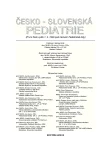Analysis of Vaccination in Children Population against Tick-borne Encephalitis in the Slovak Republic from 1997 to 2009
Authors:
V. Švihrová 1; H. Hudečková 1; J. Buchancová 1; M. Avdičová 2
Authors‘ workplace:
Ústav verejného zdravotníctva, Jesseniova lekárska fakulta Univerzity Komenského, Martin
vedúca doc. MUDr. H. Hudečková, PhD., MPH
1; Regionálny úrad verejného zdravotníctva, Banská Bystrica
vedúci MUDr. C. Klement, CSc.
2
Published in:
Čes-slov Pediat 2010; 65 (7-8): 445-451.
Category:
Original Papers
Overview
Objective:
Analysis of the vaccination frequency of children population against tick-borne encephalitis in the Slovak Republic for the period from 1997 to 2009.
Methods:
The group of 114 annotated cases of diseases in children at the age of one to 15 years with the diagnosis of tick-borne encephalitis from a total of 886 annotated cases of the disease for the period of observation from 1997 to 2009, registered in the Epidemiology information system of the Slovak Republic and 92,362 vaccinated children at the age of one to 15 years, registered during annual administrative controls of children vaccination, executed by regional offices of public health. The processing was made by descriptive methods of statistical analysis (SPSS 11.0, Excel).
Results:
The sickness rate over the 13 years has been mildly increasing. In the period of observation 93,262 children at the age of one to 15 years were vaccinated. The percentage of vaccinated children has been increasing every year and in the period of 1st September 2008 to 31st August 2009 vaccination rate reached 2.01% of children population.
In the Slovak Republic, two vaccines have been available and reimbursed from the public health resources at the present time. According to present legislation, obligatory vaccination applies for workers of virology laboratories where tick-borne encephalitis virus is processed, while vaccination is covered by the employer. The reimbursement of the vaccine is partially covered by certain health insurance companies.
Conclusions:
The virus of tick-borne encephalitis is transferred by some one to two per cent of ticks. In spite of this small number the importance of the disease is high considering its clinical seriousness. Active immunization provides possible protection. Preventive vaccination provides significant medical effect, positive economic consequences for the society and improves the quality of life of the population.
Key words:
tick-borne encephalitis, epidemiology, child age, vaccination
Sources
1. World Health Organization. International Travel and Health. Geneva: WHO, 2008.
2. Slováková A. Kliešte už začínajú útočiť. 25. 04. 2008. [cit. 2009-02-28]. Dostupné na internete: http://www.sme.sk/c/3845704/Klieste-uz-zacinaju-utocit.html.
3. Arnez M, Avsic-Zupanc T. Tick-borne encephalitis in children: an update on epidemiology and diagnosis. Expert Rev. Anti. Infect. Ther. 2009; 7: 1251–1260.
4. Mantke OD, Schädler R, Niedrig M. A survey on cases of tick-borne encephalitis in European countries [online]. Euro Surveill. 2008; 13: pii=18848. [cit. 2009-04-24]. Dostupné na internete: http://www.eurosurveillance.org/ViewArticle. aspx?ArticleId=18848.
5. Ružek D, Gritsun TS, Forrester NL, Gould EA, Kopecký J, et al. Mutations in the NS2B and NS3 genes affect mouse neuroinvasiveness of a Western European field strain of tick-borne encephalitis virus. Virology 2008; 374: 249–255.
6. Máderová E. Kliešťová encefalitída na Slovensku. Via Pract. 2005; 2: 51–54.
7. Vyhláška MZ SR č. 585/2008 Z. z., ktorou sa ustanovujú podrobnosti o prevencii a kontrole prenosných ochorení. Bratislava: Zbierka zákonov, 2008.
8. Dôvera ZP a.s. Výhody a zľavy – prevencia – kliešťová encefalitída [on-line]. 2009 [cit. 2009-04-04] Dostupné na internete: http://www.dovera.sk/ sk/aktuality/ockovaci-nadstandard-od-dovery.html.
9. Apollo ZP a.s. Produkty – Očkovanie detí proti kliešťovej encefalitíde [on-line]. 2009 [cit. 2009-04--04]. Dostupné na internete: http://www.apollo.sk/ content/clanek.php?id=1010#ocdet.
10. Union ZP a.s. Príspevok na očkovanie a vakcínu proti kliešťovej encefalitíde [on-line]. 2010 [cit. 2010-04-04]. Dostupné na internete: http://www. unionzp.sk/prispevok-na-ockovanie-a-vakcinu-proti-kliestovej-encefalitide.html.
11. Dolanský H. Prevence onemocnění klíšťovou encefalitidou z pohledu zdravotní pojišťovny. Prakt. Lék. 2008; 89: 78–81.
12. ISW International Scientific Working Group on Tick-Borne-Encephalitis [on-line]. Xth Meeting 2008, Baden near Vienna. [cit. 2009-12-09]. Dostupné na internete: http://www.tbeinfo.com/ tbe.aspx?target=75959&l=2&mark=Meeting#show_75959.
13. Suss J. Tick-borne encephalitis in Europe and beyond – the epidemiological situation as of 2007 [on-line]. Euro Surveill. 2008, 13: pii=18916. [cit. 2009-04-24]. Dostupné na internete: http://www. eurosurveillance.org/ViewArticle. aspx?ArticleId =18916.
14. Kochová I. V Česku nepřibývají lidé naočkovaní proti klíšťové encefalitidě [on-line]. Praha, 2. 12. 2009. [cit. 2010-06-05]. Dostupné na internete: http://www.mediafax.cz/domaci/2964465-V-Cesku-nepribyvaji-lide-naockovani-proti-klistove-encefalitide.
15. ÚVZ SR. Výročná správa o činnosti Úradu verejného zdravotníctva Slovenskej republiky, rok 2009. Bratislava: ÚVZ SR, 2010.
Labels
Neonatology Paediatrics General practitioner for children and adolescentsArticle was published in
Czech-Slovak Pediatrics

2010 Issue 7-8
Most read in this issue
- Present Opportunities for Treatment of Hyperphenylalaninemia
- Revised Guidelines for Diagnosis, Therapy and Prevention Cow Milk Protein Allergy
- Assessment of Arterial Wall Stiffness by Measurement of Pulse Wave Velocity in Children
- Clinical Symptoms and Laboratory Data in 75 Children with Neonatal Manifestation of Mitochondrial Disease: Proposed Diagnostic Algorithms
